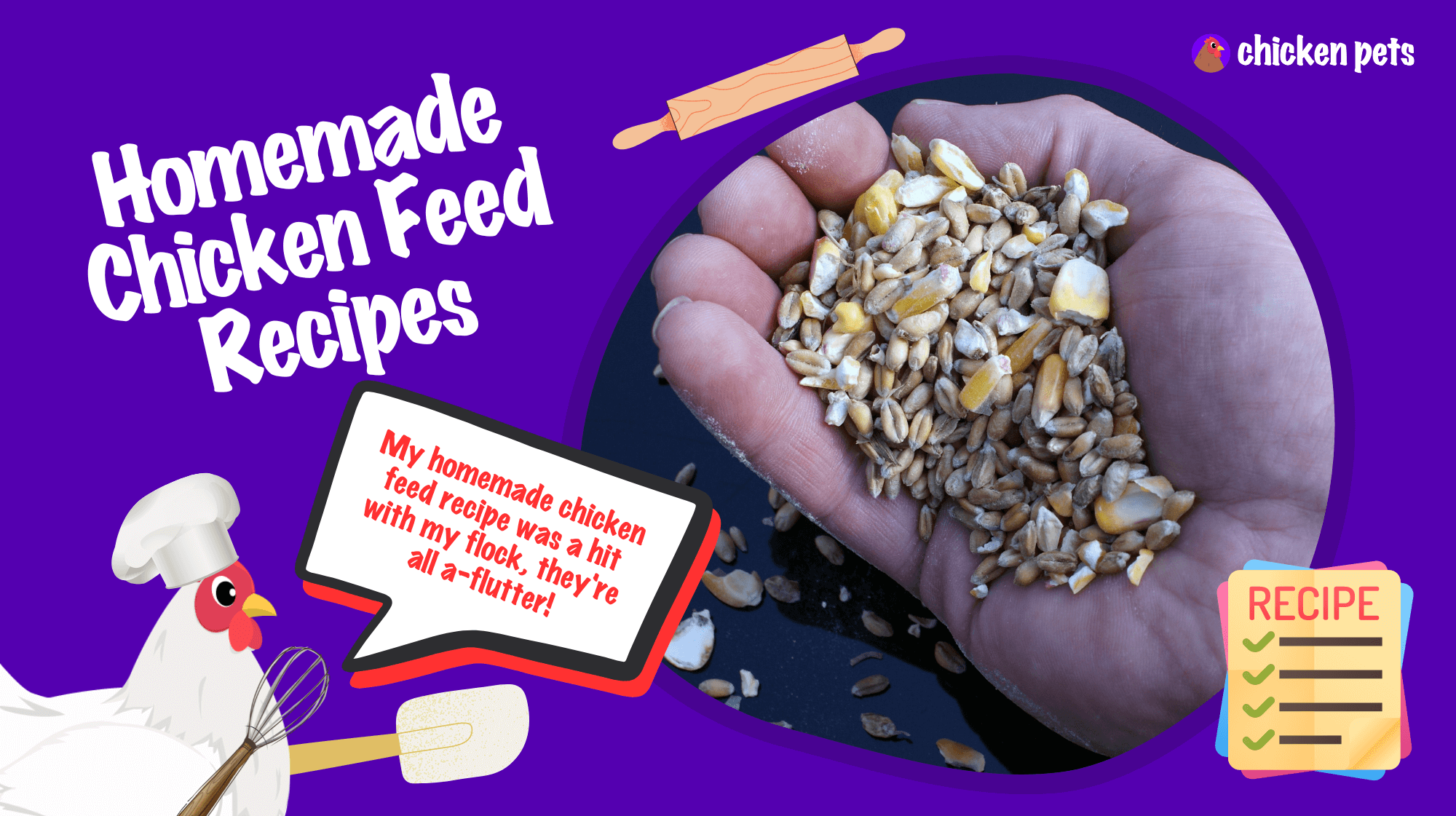Raising backyard chickens is a fulfilling and rewarding experience, but keeping them healthy and productive can be challenging. Proper nutrition is vital to their well-being and egg production, and making homemade and organic chicken feed is a cost-effective and easy way to ensure they get the nutrients they need. This comprehensive guide will teach you everything you need to know about making homemade and organic chicken feed. We will also provide helpful tips on balancing nutrition and getting the most out of your recipes.
Tip: If you’re interested in becoming a chicken keeper, you might want to start with our post, Feeding and Watering Chickens Ultimate Guide. It covers everything from balanced chicken nutrition to the types of feed and the importance of grit and calcium for strong shells.
Benefits of homemade chicken feed.
Making your own chicken feed has many benefits, including cost savings and control over ingredients. You can customize your recipes to meet your chickens’ nutritional needs and preferences, which is particularly helpful if you have chickens with different ages, breeds, and health conditions. Organic chicken feed is also a healthier option for your chickens since it contains fewer chemicals and has higher nutritional value than conventional feed.
Why you should make your own homemade chicken feed.
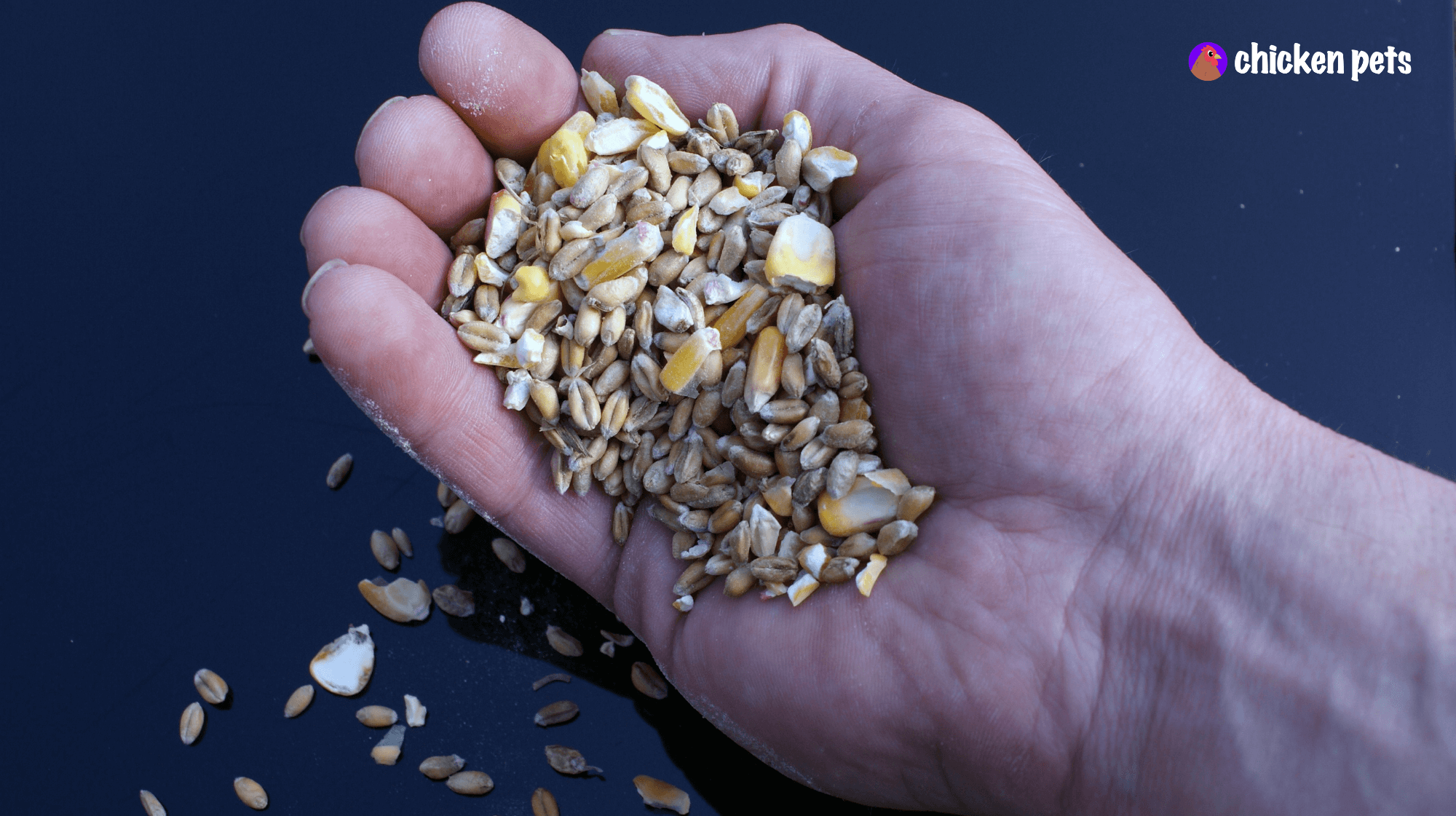
There are several compelling reasons why backyard chicken owners should consider making their own homemade chicken feed.
Greater control over what goes into your chicken feed.
Homemade chicken feed allows for greater control over the ingredients in your chickens’ diet. With store-bought feeds, knowing what your chickens are consuming can be challenging, as manufacturers may include fillers, preservatives, or other additives that don’t provide optimal nutrition. By making your own feed, you can choose high-quality, organic, and non-GMO ingredients that provide balanced nutrition for your chickens.
It could save you money in the long run.
Could you save money? Yes. Will you save money? Maybe. Another benefit of making your own homemade chicken feed is that it can save you money in the long run. While there may be an initial investment in equipment and ingredients, the cost per pound of homemade feed is often lower than store-bought feed. Additionally, by using seasonal ingredients or purchasing ingredients in bulk, you can reduce the cost of making your feed.
Opportunity for customization.
Homemade chicken feed also provides an opportunity for customization. Depending on your chickens’ age, breed, and health, you may want to modify their diet to meet specific needs. With homemade feed, you can adjust the proportions of ingredients or add supplements to create a custom blend that works best for your flock.
Rewarding experience.
Finally, making homemade chicken feed can be a fun and rewarding experience. It allows you to connect with your chickens on a deeper level, and many backyard chicken owners find making their own feed relaxing and enjoyable. Plus, you can feel good knowing you are giving your chickens the best possible care and nutrition by providing your chickens with high-quality, homemade feed.
Overall, the benefits of making your homemade chicken feed are clear. From greater control over ingredients to cost savings to customization and enjoyment, homemade feed is an intelligent choice for backyard chicken owners who want to provide their flock with optimal nutrition and care.
Homemade chicken feed vs. commercial feed.
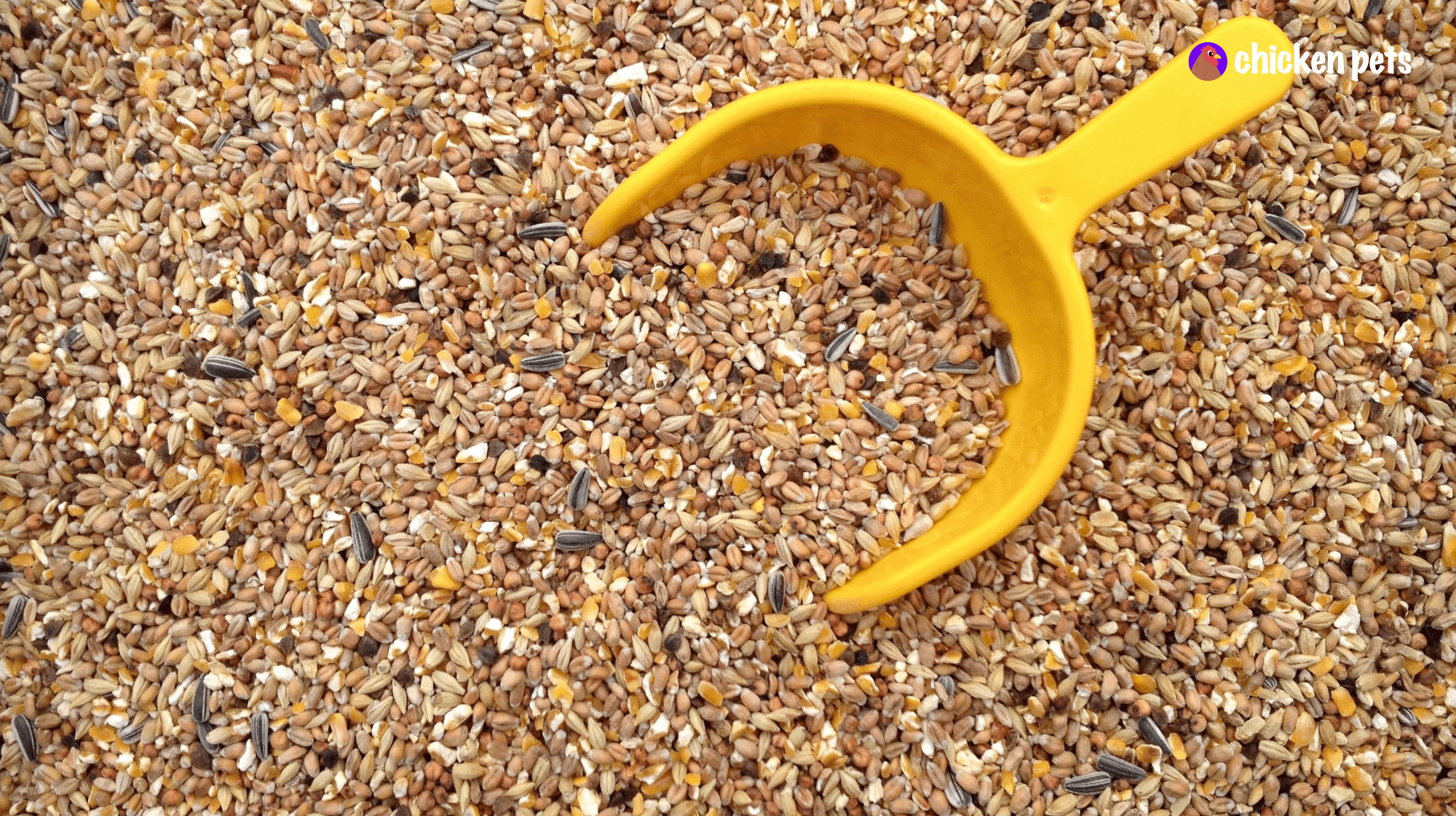
Two primary options for feeding backyard chickens are homemade chicken feed and commercial feed. These are high-level types of chicken feed, there are many others. But for this purpose, we’ll group them into these two options. While both options can provide adequate nutrition for chickens, several key differences exist.
Benefits of homemade chicken feed.
One major advantage of homemade chicken feed is that it allows for greater control over the ingredients in your chickens’ diet. With commercial feed, it can be difficult to know exactly what your chickens are consuming, as manufacturers may include fillers, preservatives, or other additives that don’t provide optimal nutrition. By making your own feed, you can choose high-quality, organic, and non-GMO ingredients that provide balanced nutrition for your chickens.
Cost considerations.
Additionally, the homemade chicken feed can be more cost-effective in the long run. While there may be an initial investment in equipment and ingredients, the cost per pound of homemade feed is often lower than store-bought feed. This is particularly true if you purchase bulk or use seasonal ingredients at a lower price.
Customization.
Another advantage of homemade chicken feed is that it allows for customization. Depending on your chickens’ age, breed, and health, you may want to modify their diet to meet specific needs. With homemade chicken feed recipes, you can adjust the proportions of ingredients or add supplements to create a custom blend that works best for your flock.
Potential downsides of homemade chicken feed.
However, there are also some potential downsides to consider regarding homemade chicken feed. Making your feed can be time-consuming and may require trial and error to get the recipe right. Additionally, ensuring that your homemade feed provides all the necessary nutrients in the right proportions can be challenging, which can lead to health problems for your chickens if not done correctly.
Benefits of commercial feed.
On the other hand, commercial chicken feed is convenient and easy to use, and it provides a balanced mix of nutrients designed to meet the needs of chickens at different life stages. Commercial feed is often fortified with vitamins and minerals that may be lacking in homemade feed.
Potential downsides of commercial feed.
However, there are also some potential downsides to consider with commercial feed. As mentioned, knowing what your chickens are consuming can be challenging, as manufacturers may include fillers, preservatives, or other additives. Additionally, the commercial feed can be more expensive in the long run than homemade feed.
Overall, homemade and commercial chicken feed can provide adequate nutrition for backyard chickens. The decision of which to use ultimately comes down to personal preference and individual flock needs. However, homemade chicken feed may be the better choice for those who want greater control over their chickens’ diet, the potential cost savings, and the opportunity for customization.
What ingredients you need to make homemade chicken feed.
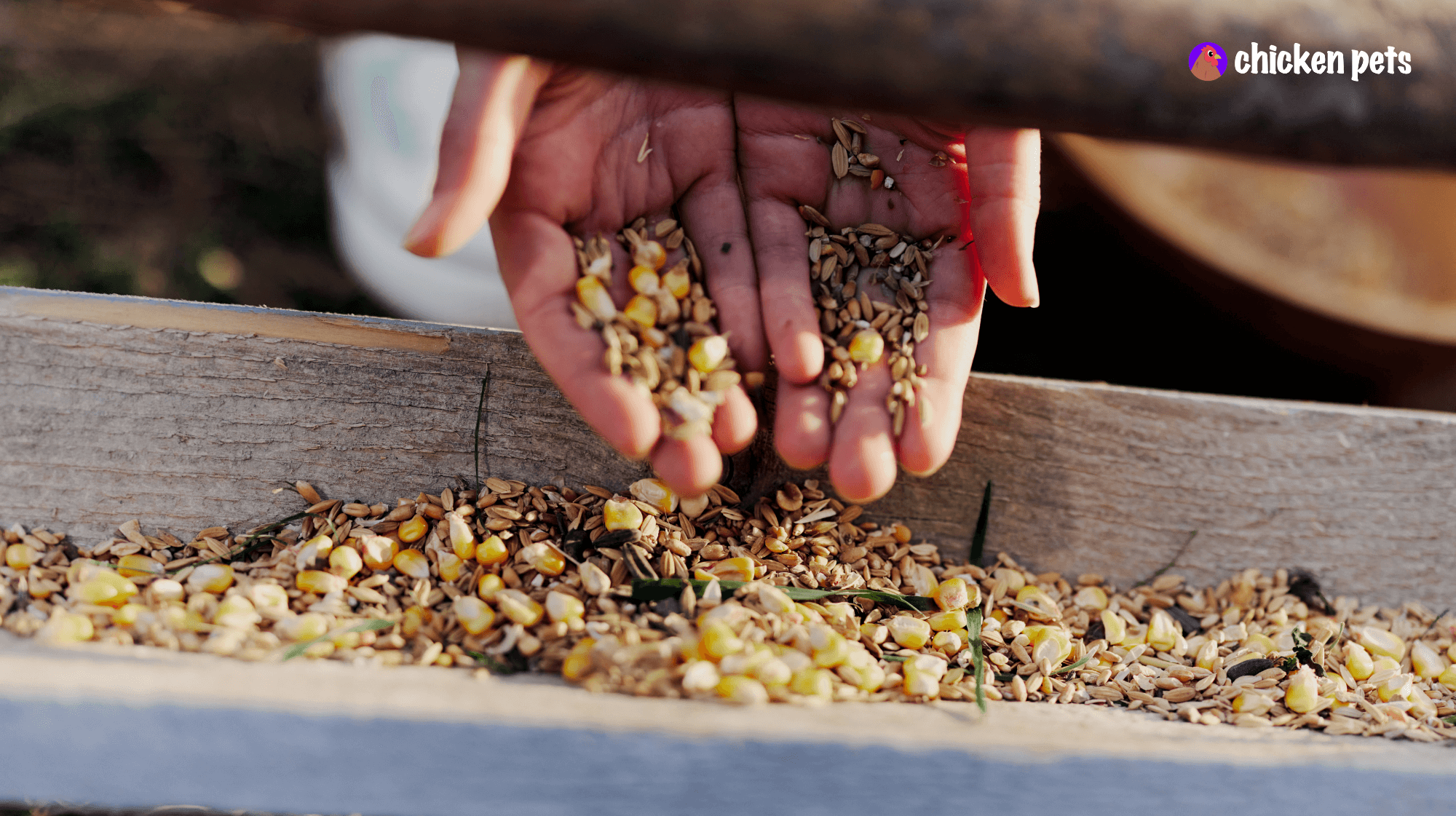
Suppose you’re interested in making homemade chicken feed for your backyard flock. In that case, there are several vital ingredients that you’ll need to include in your basic chicken feed recipe to ensure proper nutrition.
Grains and seeds.
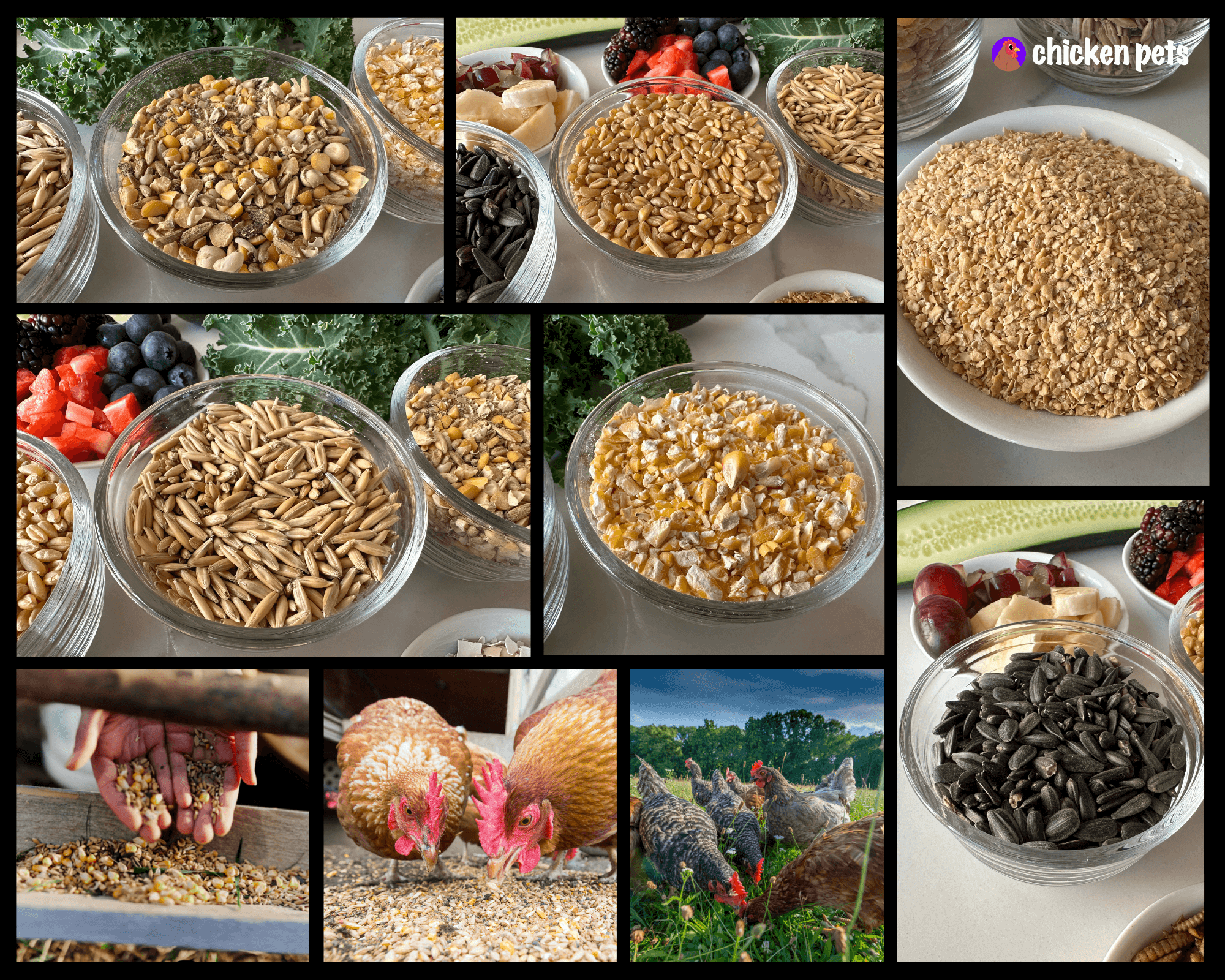
The foundation of any chicken feed recipe is grains and seeds, which provide carbohydrates, protein, and essential amino acids. Standard options include wheat, oats, barley, and corn, as well as sunflower seeds, flax seeds, and sesame seeds. When selecting grains and seeds for organic feed, choosing high-quality, organic options is essential to ensure optimal nutrition for your chickens.
- Wheat and whole grains
- Oats or Barley
- Corn, Cracked corn
- Sunflower seeds, Black oil sunflower seeds, black sunflower seeds
- Split peas, field peas
- Flax seed
- Sesame seeds
- Millet
- Quinoa
- Sorghum
- Buckwheat
- Hemp seeds
- Pumpkin seeds
- Chia seeds
- Poppy seeds
Supplements.
In addition to grains and seeds, supplements can be added to homemade chicken feed to provide additional nutrients that may be lacking. For example, adding dried mealworms to mixed feed can increase protein levels, while crushed eggshells can provide calcium. Other supplements to consider include fish meal, kelp meal, and probiotics.
- Dried mealworms (for increased protein levels)
- Crushed eggshells (for calcium)
- Fish meal
- Kelp meal
- Probiotics
- Brewer’s yeast (for B vitamins and protein)
- Dried seaweed (for minerals and trace elements)
- Alfalfa meal (for protein and fiber)
- Garlic (as a natural immune booster)
- Apple cider vinegar (for digestive health)
Seasonal ingredients.
Finally, incorporating seasonal ingredients into your homemade chicken feed can provide a cost-effective way to add variety and nutrition to your flock’s diet. In the summer, you might add fresh fruits and vegetables, such as berries or leafy greens, while in the winter, you might incorporate root vegetables, like carrots or sweet potatoes. Just be sure to research which seasonal ingredients are safe for chickens, as some fruits and vegetables can be toxic.
- Summer – Watermelon, Cantaloupe, Grapes, Peaches, Basil, Mint, Dill, Chard
- Fall – Brussel sprouts, Broccoli, Cauliflower, Swiss chard, Turnips, Radishes, Sage, Thyme
- Winter – Brussels sprouts, Broccoli, Cauliflower, Celery, Collard greens, Mustard greens, Parsley, Rosemary
- Spring – Arugula, Cilantro, Fennel, Green beans, Pea shoots, Radicchio, Sorrel, Tarragon, leafy greens, fresh greens
Again, it’s important to note that while seasonal ingredients can provide variety and nutrition in your chicken’s diet, not all fruits and vegetables are safe for chickens to eat. Additionally, seasonal ingredients should be used in moderation and balanced with other elements to ensure your chickens have a balanced diet.
Where to get ingredients for homemade poultry feed recipe.

When making homemade poultry feed, there are various options for sourcing ingredients. Here are a few places to consider:
- Local feed mills – Many areas have local feed mills that sell bulk grains and other ingredients in larger quantities. These can be excellent options for buying in bulk and saving money on homemade poultry feed.
- Co-ops and farm supply stores – Co-ops and farm supply stores often carry a variety of feed and supplement options for poultry. They may also have knowledgeable staff to help you select the right ingredients for your flock.
- Local feed store – Local feed stores may carry a variety of ingredients, but you can also ask them to order specific items if needed. It can be worth asking if they offer discounts for bulk orders.
- Online retailers – Various online retailers sell poultry feed and supplements, including specialty organic and non-GMO options. While online shopping may be convenient, read reviews and check the company’s reputation before purchasing.
- Local farmers and homesteaders – If you have a local farmer’s market or know of other homesteaders in your area, they may be able to sell or trade ingredients for homemade poultry feed. This can be a great way to source fresh, local ingredients and connect with other poultry enthusiasts.
- Growing your ingredients – Depending on your location and space availability, you may be able to grow some of the ingredients for your homemade poultry feed. For example, planting a small patch of sunflowers can provide a source of seeds for your flock.
It’s important to note that when sourcing ingredients for homemade poultry feed, selecting high-quality, fresh ingredients appropriate for your flock’s nutritional needs is essential.
When to make homemade chicken feed.

Homemade chicken feed can be made any time of the year, but there are a few factors to consider when deciding when to make it. Here are some things to keep in mind:
- Time of year – Depending on where you live, certain ingredients for homemade chicken feed may be more readily available during different seasons. For example, fresh fruits and vegetables like watermelon and leafy greens may be abundant in the summer. In contrast, in the winter, root vegetables like carrots and parsnips may be more readily available. Incorporating seasonal ingredients into your homemade feed can provide variety and nutrition for your chickens.
- Nutritional needs of your flock – Different stages of chicken life require different nutrition levels. For example, chicks require more protein and higher levels of specific vitamins and minerals than adult birds. Laying hens also have specific nutritional needs to support egg production. Understanding the nutritional needs of your flock and adjusting your homemade feed recipes accordingly can help ensure that your chickens are getting the nutrients they need.
- Cost savings – One of the benefits of making homemade chicken feed is cost savings over store-bought feed. Depending on the availability of ingredients and seasonal prices, there may be certain times of the year when it is more cost-effective to make your feed. Keep an eye on costs and consider buying ingredients in bulk to save money.
- Storage considerations – Homemade chicken feed can be more perishable than store-bought feed, so it’s important to consider storage. Be sure to store ingredients properly to prevent spoilage, and consider making smaller batches if you are concerned about shelf life.
In general, making homemade chicken feed can be done year-round. Still, it’s essential to consider your flock’s nutritional needs, ingredients availability, cost savings, and storage considerations when deciding when to make it.
Where to make your homemade chicken feed.
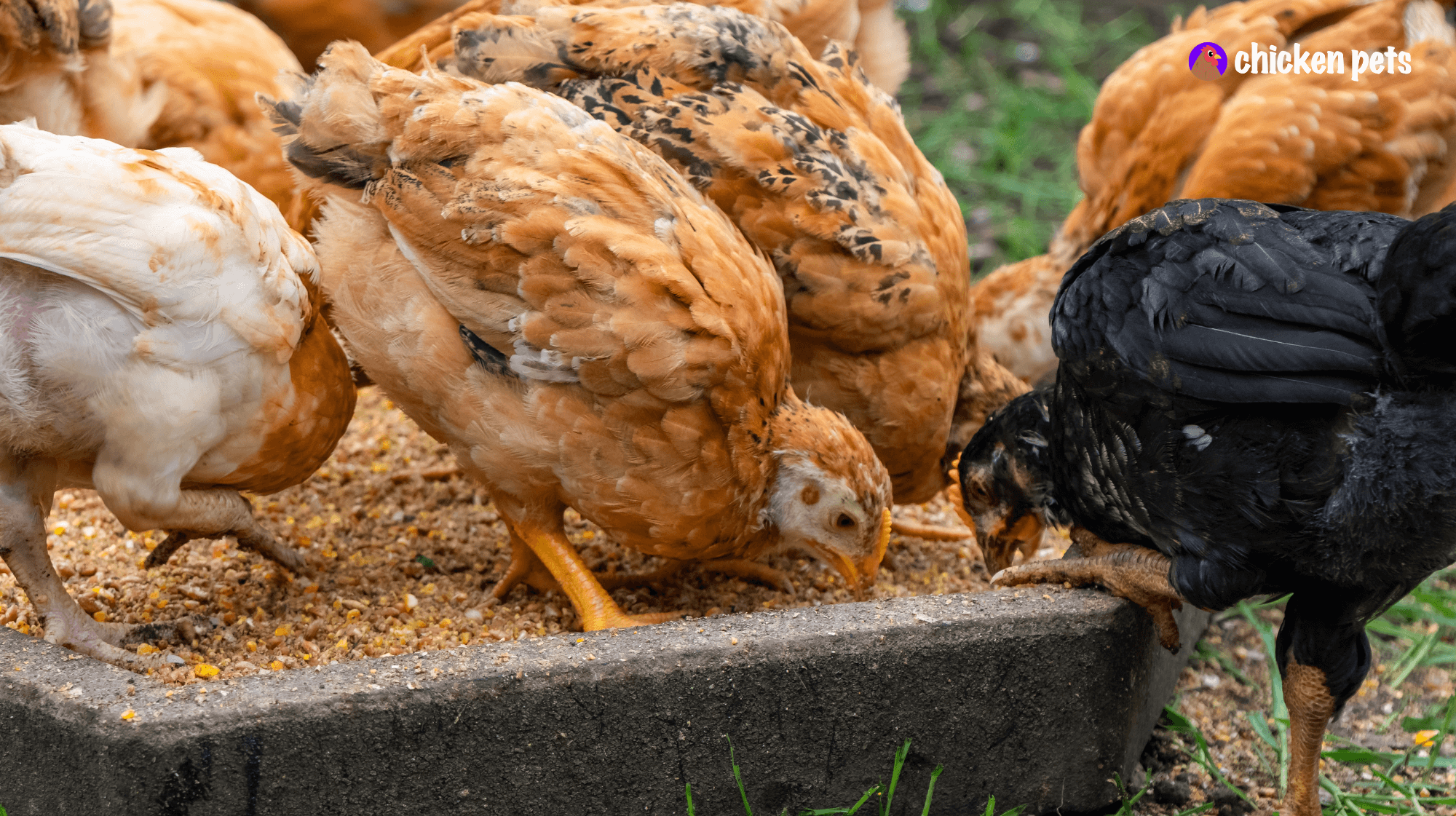
Making homemade chicken can be done in various locations, depending on your setup and preferences. Here are some options for where to make your homemade chicken feed:
- Kitchen – If you have a small flock, you can make your homemade feed in your kitchen using standard kitchen tools like measuring cups, mixing bowls, and a food processor or blender. This option can be convenient if you have limited space or prefer to keep your feed-making activities indoors.
- Garage or barn – If you have a larger flock or prefer to keep your feed-making activities separate from your kitchen, let’s set up a dedicated area in your garage or barn. This can be as simple as a workbench or table with essential tools like a grinder or mixing paddle. Just be sure to keep the area clean and free of contaminants to prevent spoilage or contamination of your feed.
- Outdoor area – Some backyard chicken keepers prefer to make their homemade feed outside for convenience or to avoid mess and odors. You can set up a workspace with essential tools and equipment if you have a covered outdoor area. Protect your ingredients from moisture and pests, and keep everything clean to prevent contamination.
- Feed mill – If you have a larger flock or want to make larger batches of homemade feed, consider using a feed mill. Feed mills are specialized equipment that can grind and mix large quantities of feed quickly and efficiently, and some mills can even add supplements and other ingredients automatically. Feed mills can be expensive, but they can also save time and effort if you make feed in large quantities.
You can make homemade chicken feed anywhere that is clean, dry, and contaminant-free. Consider the size of your flock, the available tools and equipment, and preferences when deciding where to make your homemade feed.
How to make your chicken feed.

Making homemade chicken feed is easier than you might think, and it can be a great way to ensure that your chickens get the best possible nutrition. Here is a step-by-step guide on how to make your homemade chicken feed:
- Step 1 – Gather your ingredients. To make homemade chicken feed, you will need a variety of grains, seeds, and supplements. Some common ingredients include corn, wheat, oats, barley, sunflower seeds, flax seeds, dried mealworms, crushed eggshells, fish meal, kelp meal, and probiotics.
- Step 2 – Measure and mix the ingredients. Once you have gathered your ingredients, you will need to measure them according to a recipe or based on the needs of your specific flock. You can mix the ingredients in a large bowl or bucket or use a feed mixer if one is available. Mixing feed can also be done by grinding food in a processor.
- Step 3 – Store the feed. Once your homemade chicken feed is mixed, store it in a cool, dry place. Use airtight containers or bags to keep the feed fresh and free from pests.
- Step 4 – Feed your chickens. When it’s time to feed your chickens, offer them homemade feed in a clean, dry feeder. Monitor their intake and adjust the amount of feed as needed to ensure they get the right amount of nutrition.
- Step 5 – Monitor your chickens’ health and egg production. After feeding your chickens homemade feed for a few weeks, monitor their health and egg production to see if there are any changes. If you notice any issues, adjust the recipe or feeding regimen accordingly.
Making homemade chicken feed can be a great way to provide your chickens with high-quality nutrition while saving money. Following these simple steps, you can make your homemade chicken feed and feel confident that your chickens are getting the best possible care.
Recipe 1: Homemade chicken feed recipe.
Looking for a cost-effective and healthy alternative to commercial chicken feed? Look no further than this homemade chicken feed recipe. Packed with a variety of grains, seeds, and supplements, this recipe is perfect for providing your chickens with all the nutrients they need to thrive. Plus, it’s easy to make and can be customized to your chickens’ specific dietary needs. Follow these simple instructions to get started.
Ingredients:
- 4 cups of wheat
- 3 cups of oats
- 2 cups of cracked corn
- 1 cup of sunflower seeds
- 1 cup of split peas
- 1 cup of flax seeds
- 1 cup of sesame seeds
- 1 cup of millet
- 1 cup of quinoa
- 1/2 cup of dried mealworms
- 1/4 cup of crushed eggshells
- 2 tablespoons of fish meal
- 2 tablespoons of kelp meal
- 1 tablespoon of probiotics
Instructions:
- Mix all of the grains and seeds in a large mixing bowl.
- Add in the supplements and mix thoroughly.
- Store the mixture in an airtight container in a cool, dry place until ready to use.
- Feed to chickens as desired, providing approximately 1/4 to 1/3 cup per bird per day, adjusting the amount as needed based on their appetite.
Recipe 2: DIY chicken feed recipe. Seasonal chicken feed recipe.
This DIY chicken feed recipe is designed to provide your feathered friends with a healthy, nutritious diet that changes with the seasons. By incorporating a variety of whole grains, seeds, and seasonal vegetables, you can give your chickens the nutrients they need to stay healthy and happy. This recipe is easy to make and can be adjusted based on your chickens’ appetites and dietary needs.
Ingredients:
- 4 cups of wheat
- 3 cups of oats
- 2 cups of barley
- 1 cup of sunflower seeds
- 1 cup of pumpkin seeds (or other seasonal seeds)
- 1 cup of split peas
- 1 cup of flax seeds
- 1 cup of sesame seeds
- 1 cup of quinoa
- 1/2 cup of dried mealworms
- 1/4 cup of crushed eggshells
- 2 tablespoons of fish meal
- 2 tablespoons of kelp meal
- 1 tablespoon of probiotics
- 2 cups of seasonal vegetables (e.g., leafy greens in the summer, pumpkins in the fall, sweet potatoes in the winter, peas in the spring)
Instructions:
- Mix all of the grains and seeds in a large mixing bowl.
- Add in the supplements and mix thoroughly.
- Chop or shred the seasonal vegetables and mix them into the grain and seed mixture.
- Store the mixture in an airtight container in a cool, dry place until ready to use.
- Feed to chickens as desired, providing approximately 1/4 to 1/3 cup per bird per day, adjusting the amount as needed based on their appetite.
Recipe 3: Whole grain chicken feed recipe.
This whole grain chicken feed recipe provides your feathered friends with a nutritious and balanced diet. With ingredients like wheat, cracked corn, and black oil sunflower seeds, it’s packed with the essential nutrients chickens need to stay healthy. Plus, the addition of flax seeds and kelp meal gives them an extra boost. This easy-to-follow recipe is sure to be a hit with both you and your chickens.
Ingredients:
- 2 cups wheat
- 2 cups cracked corn
- 2 cups whole oats
- 1 cup black oil sunflower seeds
- 1 cup flax seeds
- 1/2 cup sesame seeds
- 1/2 cup dried mealworms
- 1/2 cup kelp meal
Instructions:
- Combine all ingredients in a large mixing bowl.
- Store in an airtight container in a cool, dry place.
- Feed to chickens as desired, offering fresh water at all times.
Recipe 4: Crumble chicken feed.
This crumble chicken feed recipe is an easy and cost-effective way to provide your chickens with the nutrients they need. Made with a variety of grains and seeds, as well as alfalfa meal and dried mealworms, this feed will keep your feathered friends healthy and happy. Simply pulse the ingredients together in a food processor, store in an airtight container, and feed to your chickens as desired.
Ingredients:
- 2 cups wheat
- 2 cups whole oats
- 2 cups barley
- 1 cup sunflower seeds
- 1 cup flax seeds
- 1/2 cup alfalfa meal
- 1/2 cup dried mealworms
- 1/2 cup crushed eggshells
Instructions:
- Combine all ingredients in a food processor and pulse until coarsely ground.
- Store in an airtight container in a cool, dry place.
- Feed to chickens as desired, offering fresh water at all times.
Recipe 5: Seasonal chicken feed (Fall).
This Fall Seasonal Chicken Feed recipe is a nutritious and tasty option to keep your feathered friends happy and healthy. With a combination of whole grains, seeds, dried fruit, and kelp meal, it provides a balanced diet for your chickens during the fall season. Simple to make and store, this recipe ensures that your chickens receive the necessary nutrients they need to thrive. Follow the instructions below to create your own homemade Fall Seasonal Chicken Feed.
Ingredients:
- 2 cups wheat
- 2 cups whole oats
- 1 cup pumpkin seeds
- 1 cup sunflower seeds
- 1/2 cup flax seeds
- 1/2 cup dried cranberries
- 1/2 cup dried apple pieces
- 1/4 cup kelp meal
Instructions:
- Combine all ingredients in a large mixing bowl.
- Store in an airtight container in a cool, dry place.
- Feed to chickens as desired, offering fresh water at all times.
Recipe 6: Meat chickens feed recipe.
Meat chickens have different nutritional requirements than laying hens, so creating a feed recipe optimized for their growth and development is vital. Here’s a recipe that is specifically designed for balanced feed used for meat chickens:
Ingredients:
- 10 pounds of wheat
- 10 pounds of corn
- 10 pounds of barley
- 5 pounds of split peas
- 5 pounds of sunflower seeds
- 2 pounds of flaxseed
- 2 pounds of sesame seeds
- 1 pound of dried mealworms
- 1 pound of kelp meal
- 1 pound of fish meal
- 1 pound of alfalfa meal
- 1 pound of probiotics
- 1/2 pound of garlic powder
Instructions:
- Combine all dry ingredients in a large container, mixing thoroughly.
- Add probiotics to the mixture and mix again.
- Store in a cool, dry place in an airtight container.
- Feed the meat chickens 2-3 times per day, providing enough feed so they can access it at all times.
- Monitor the chickens’ growth and adjust the amount of feed accordingly.
This recipe provides a balanced blend of grains, seeds, and supplements that will support the growth and development of meat chickens. The high protein content from the split peas, sunflower seeds, and mealworms will promote muscle growth, while the kelp meal and alfalfa meal will provide essential vitamins and minerals. The garlic powder will act as a natural immune booster, helping to keep the chickens healthy. With this recipe, you can be sure your meat chickens get the nutrients they need to thrive.
What should be in a chicken’s diet?

A well-balanced diet is crucial for the health and well-being of your chickens. Here are some key elements that should be included in a chicken’s diet:
- Protein – Chickens need protein for growth, feather development, and egg production. Good protein sources include soybean meal, fish meal, and dried mealworms.
- Carbohydrates – Carbohydrates provide energy for chickens and help them maintain body weight. Grains like corn, wheat, and barley are good sources of carbohydrates.
- Fats – Fats are essential for chickens to maintain healthy skin and feathers and to produce and maintain egg production. Good sources of fats include sunflower seeds and flax seeds.
- Vitamins – Chickens require a variety of vitamins to maintain optimal health. Vitamins A, D, E, and K are particularly important and can be found in leafy greens, carrots, and egg yolks.
- Minerals – Calcium is essential for strong bones and eggshells. Calcium can be found in oyster shells, crushed eggshells, and bone meal. Other minerals like phosphorus, iron, and zinc are crucial for overall health and can be found in various feed ingredients.
- Water – Clean and fresh water should always be available to chickens. Water is essential for proper digestion, egg production, and overall health.
It’s important to note that chickens require different amounts of these nutrients depending on their age, breed, and activity level. For meat birds, young chickens and laying hens need more protein than older or non-laying chickens. For more information, see our post, What do chickens eat?
What does it mean when chickens free range?

Free-ranging is a term used to describe raising chickens where they can roam freely outside their coop or pen. Here are some key points to help you understand what it means when chickens free-range:
- Access to a larger area: When chickens are free-range, they are given access to a larger area to explore and forage for food. This area can be a pasture, field, or backyard.
- Natural diet: Free-ranging chickens have the opportunity to forage for their food, which includes bugs, worms, and plants. This provides a more natural diet for the chickens and can help improve the quality and taste of their eggs.
- Exercise: Free-ranging chickens have more space to move around and can engage in more physical activity than chickens confined to a small pen or coop, which can help improve their overall health and well-being.
- Socialization: Free-ranging chickens are more likely to interact with each other and form social bonds. This can help reduce stress and improve the social dynamics within a flock.
- Increased risk of predation: When chickens are free-range, they are more exposed to predators such as hawks, foxes, and raccoons. Protecting your flock from these predators is essential, such as providing a secure coop and run or watching your chickens.
Free-ranging can be an excellent option for raising chickens, but weighing the benefits against the potential risks and making an informed decision based on your situation and needs to raise chickens is essential.
Homemade feeding tips for chickens.
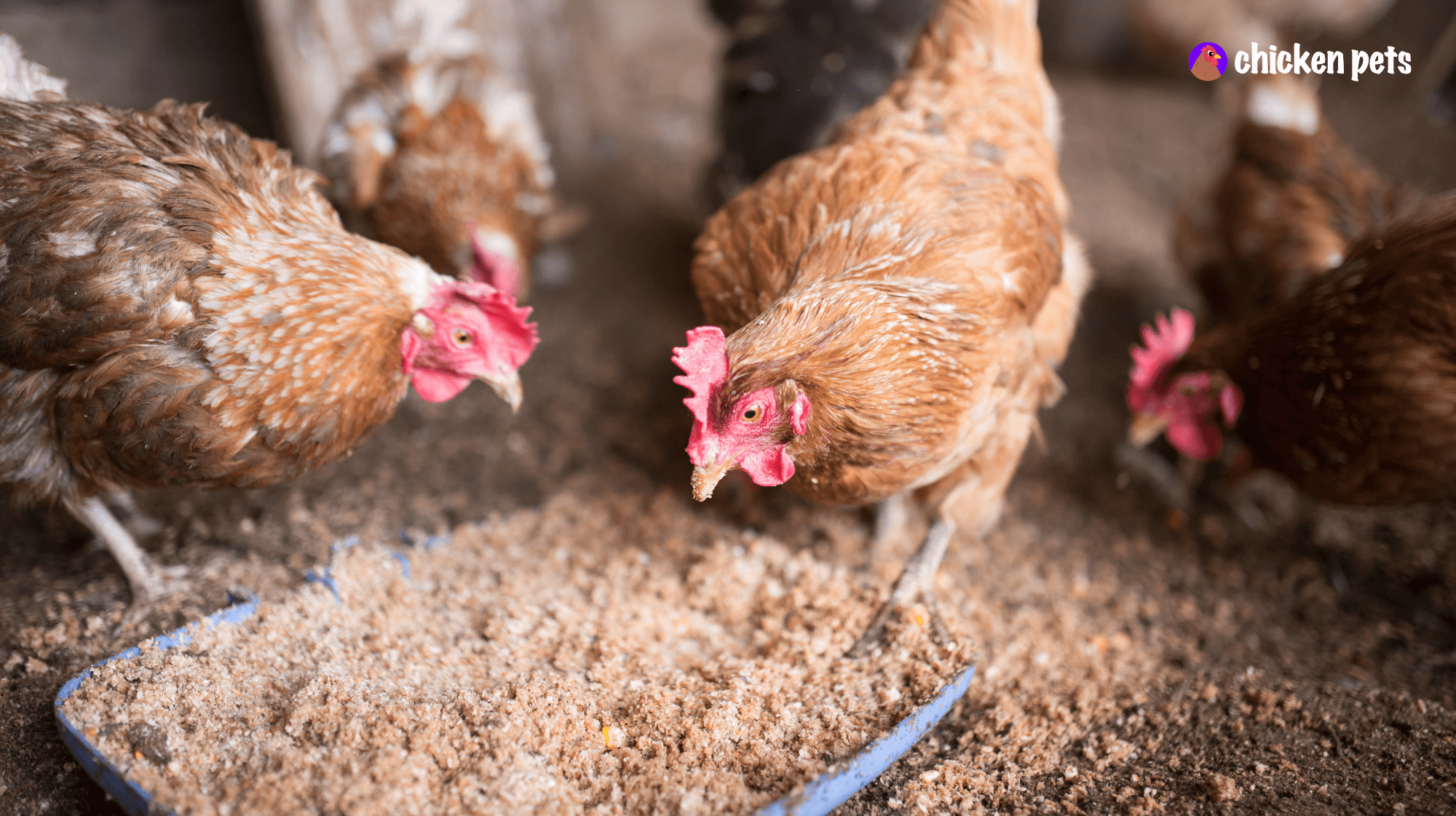
Raising backyard chickens can be a fun and rewarding experience, but ensuring they are adequately fed and cared for is crucial to their health and well-being. Providing homemade chicken feed can be a great way to control the quality and cost of feeding chickens and their diet, but it’s essential to do it correctly. Here are ten tips for homemade feeding from our experience to help ensure your chickens get the nutrition they need to thrive.
- Research and learn about your chicken’s nutritional needs: Before making your chicken feed, it’s essential to study and understand the dietary requirements of your flock based on their age, breed, and purpose (egg-laying or meat production).
- Use high-quality ingredients: When selecting ingredients for your homemade feed, choose high-quality options free from chemicals and contaminants and suitable for chickens.
- Use a balanced formula: Ensure your feed formula includes the right protein, carbohydrates, fats, vitamins, and minerals for your chickens to maintain optimal health.
- Mix feed well: It’s important to mix all of the ingredients well to ensure that your chickens receive a balanced diet with each feeding.
- Store feed properly: Store your homemade feed in a cool, dry place to prevent spoilage and contamination.
- Offer supplemental nutrition: Besides the homemade feed, consider offering your chickens supplements such as oyster shells for calcium, grit for digestion, and probiotics for immune health.
- Offer a variety of foods: Like humans, chickens appreciate variety. Offering a variety of fruits, vegetables, and treats can keep your chickens healthy and happy.
- Monitor your chickens’ health: Keep an eye on your chickens’ weight, behavior, and egg production to ensure they receive proper nutrition.
- Adjust feed as needed: If your chickens’ health declines, consider adjusting their feed formula or offering supplements to address their needs.
- Consult with an expert: If you need clarification on making your feed or have concerns about your chickens’ nutrition, seek advice from a poultry expert or veterinarian.
Safety considerations for chicken food handling and storage.
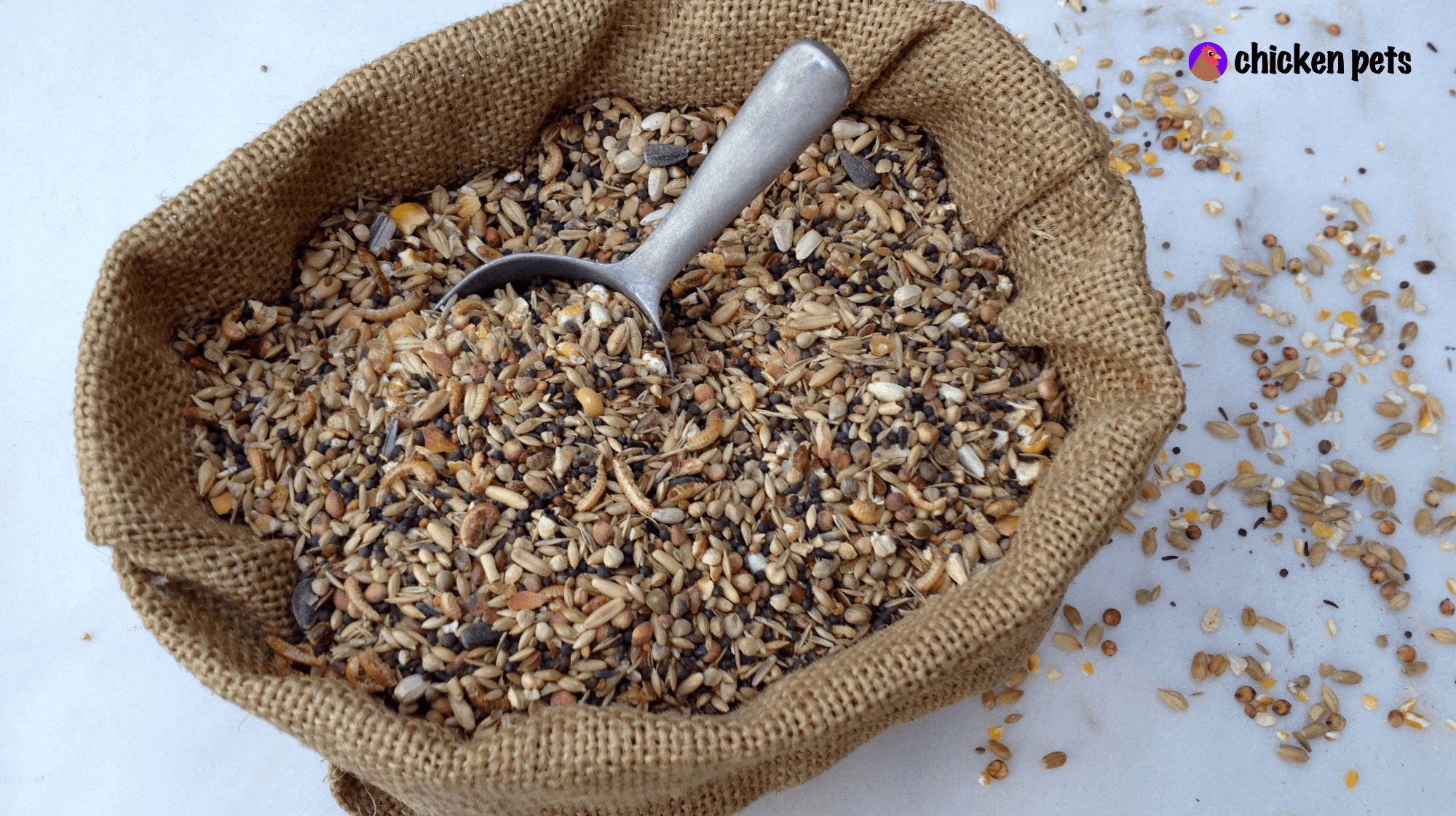
When it comes to homemade chicken feed, it’s essential to keep food handling and storage safety in mind to prevent contamination and spoilage. Here are some safety considerations to keep in mind when handling and storing homemade chicken feed:
- Use clean equipment and surfaces: Before making chicken feed, ensure all equipment and characters are clean and free from debris.
- Wash your hands: Be sure to wash your hands thoroughly with soap and water before and after handling chicken feed.
- Store feed in airtight containers: To prevent spoilage and pests, store your homemade chicken feed in airtight containers in a cool, dry place.
- Label containers: Clearly label all chicken feed containers with the date it was made and the ingredients included.
- Use fresh ingredients: Use only high-quality ingredients when making the chicken feed to ensure optimal nutrition.
- Avoid cross-contamination: Keep different types of feed separate to prevent cross-contamination.
- Clean and sanitize feeders and waterers: Regularly clean and sanitize your chicken feeders and waterers to prevent the growth of harmful bacteria.
- Monitor feed for signs of spoilage: Check feed regularly for signs of mold or other spoilage, and dispose of any spoiled feed immediately.
- Don’t mix old and new feed: When adding new feed to a container, empty any old feed first.
- Keep an eye on your chickens: Monitor your chickens for signs of illness or decreased egg production, which may indicate that the feed has spoiled or is not providing adequate nutrition.
Following this safety, ensure your homemade chicken feed mix is safe and nutritious for your chickens.
What to do about picky chickens?
If your chickens are picky eaters, gradually introduce new foods to their diet to expand their palate. You can also try mixing fresh foods with their current feed to make the transition smoother. A varied diet with different textures and flavors can help prevent boredom and picky eating.
Do I need to add any dietary fats?
Dietary fats are essential to a chicken’s diet as they provide energy and help with nutrient absorption. Good sources of dietary fats for chickens include flaxseed, sunflower seeds, and fish oil.
What about fermented feed?
Fermented feed is a popular option for homemade chicken feed as it can increase nutrient absorption and provide beneficial probiotics. To make fermented feed, mix your desired grains and seeds with water and a starter culture, such as whey or apple cider vinegar, and allow it to ferment for 24-48 hours before feeding.
Do I need to do anything special for free-range chickens?
Free-range chickens have access to a wider variety of foods than chickens kept in a coop, but it’s still essential to provide a balanced diet that meets their nutritional needs. Offering supplemental feed in addition to what they forage can help ensure they’re getting all the nutrients they need.
Is it ok to start with commercial feeds?
Yes, starting with commercial feeds is a common way to raise chickens. However, transitioning to homemade feeds can provide cost savings and allow for greater control over the ingredients in their diet. Researching and ensuring that the commercial feed you choose is high quality and meets your chickens’ nutritional needs is essential.
Wrap up: Making homemade poultry feeds.
Making homemade and organic chicken feed is a cost-effective and easy way to provide your chickens with proper nutrition. These tips and recipes can keep your chickens healthy, happy, and productive.
However, it’s essential to remember that making homemade chicken feed requires careful attention to detail and some upfront investment in equipment and ingredients. You will need a scale to measure the ingredients accurately, and it’s important to source high-quality grains and supplements to ensure that the feed meets your chickens’ nutritional needs.
When starting, it’s a good idea to experiment with small batches of feed and monitor your chickens’ health and egg production to ensure the feed provides the necessary nutrients. It’s also essential to seek expert advice or join a local backyard chicken group to learn from other chicken owners and share your experiences.
In conclusion, making homemade and organic chicken feed is a great way to ensure your backyard chickens get the nutrients they need to stay healthy and productive. Following the tips and recipes outlined in this guide, you can create a customized and balanced chicken feed that meets your chickens’ nutritional needs, saves money, and helps you maintain control over the ingredients. With a little effort and experimentation, you can become a pro at making homemade chicken feed and provide your feathered friends with delicious and nutritious meals.

